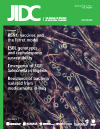Pneumococcal disease: emergence of serotypes 19A and 7F following conjugate pneumococcal vaccination in a Mexican hospital
DOI:
https://doi.org/10.3855/jidc.1954Keywords:
Streptococcus pneumoniae, pneumococcal invasive disease, pneumococcal conjugate vaccines, serotypes 19A and 7F, MexicoAbstract
Introduction: Mexico was the first country to initiate massive vaccination with heptavalent pneumococcal conjugate vaccine (PCV-7) in children. There is no information regarding pneumococcal invasive disease (PID) in children before and after implementation of PCV-7 in Mexico or elsewhere in Latin America.
Methodology: During October 2005 to September 2010, active surveillance for pediatric PID was initiated at Tijuana General Hospital. Only culture-confirmed cases from sterile fluids were included in the study. Serotype identification was also performed.
Results: Twenty-eight pediatric PID cases were confirmed. Streptococcus pneumoniae was the main cause of pleural empyema (n = 13). It was also the second most common cause of confirmed bacterial meningitis (n = 10), followed by Neisseria meningitidis (n = ?), and the only cause of otomastoiditis with bacterial isolation (n = 5). Vaccine-associated serotypes decreased from 54% before PCV-7 introduction to the vaccination schedule, to only 5.6% after PCV-7 implementation. Serotypes 19A and 7F (47% and 33% respectively) were predominant following PCV-7 vaccination.
Conclusions: Serotype substitution in PID is present in the northern border of Mexico following PCV-7 vaccination in children.
Downloads
Published
How to Cite
Issue
Section
License
Authors who publish with this journal agree to the following terms:
- Authors retain copyright and grant the journal right of first publication with the work simultaneously licensed under a Creative Commons Attribution License that allows others to share the work with an acknowledgement of the work's authorship and initial publication in this journal.
- Authors are able to enter into separate, additional contractual arrangements for the non-exclusive distribution of the journal's published version of the work (e.g., post it to an institutional repository or publish it in a book), with an acknowledgement of its initial publication in this journal.
- Authors are permitted and encouraged to post their work online (e.g., in institutional repositories or on their website) prior to and during the submission process, as it can lead to productive exchanges, as well as earlier and greater citation of published work (See The Effect of Open Access).








